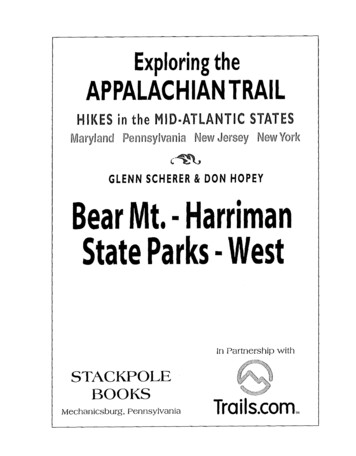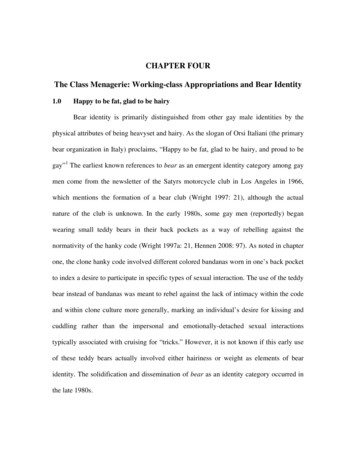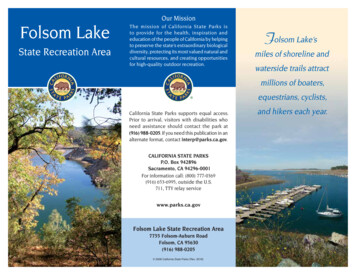
Transcription
Exploring theAPPALACHIAN TRAILHIKES in the MID·ATLANTIC STATESMaryland Pennsylvania New Jersey New Yort , GLENN SCHERER & DON HOPEYBear Mt. · HarrimanState Parks · WestIn Partnership withSTACKPOLEBOOKSMechanicsburg, pennsylvaniaTra iIs.comT"
HIKE #35Bear Mt.-Harriman State Parks - WestMaps: ATC N.Y. & N.J. Map 3; NY-NJTCHarriman Map NorthRoute: In Bear Mt.-Harriman SP, fromArden Valley Rd. (Elk Pen) to IslandPond, Surebridge Mt., and ArdenValley Rd. at Tiorati CircleRecommended direction: S to NDistance: 5.7 mi. total; 5.5 mi. on ATAccess trail name & length: Arden Valley Rd.lRamapo-Dunderberg Trail,0.2 mi.Elevation /-: 550 to 1328 to 1050 ft.Effort: ModerateDay hike: YesOvernight backpacking hike: OptionalDuration: 31h hr.Early exit option: At 4.1 mi., Hurst TrailNatural history features: Green PondMt.; Island Pond; Lemon Squeezer;Surebridge Mt.; Fingerboard Mt.Social history features: Clove Furnace;Civilian Conservation Corps spillway;Long Path; Ramapo-DunderbergTrail; Surebridge Mine Rd.; Greenwood Mine; first miles of AT ever builtTrailhead access: Start: Take NY 17 1.9mi. N of Southfields or 0.7 mi. S ofArden to Arden Valley Rd. and go0.3 mi. E to Elk Pen parking area(overnight). End: Continue past ElkPen parking area on Arden ValleyRd. 3.5 mi to Tiorati Circle parkingarea (overnight).Camping: Fingerboard ShelterTimate route of the very first 5.5 mi.of Appalachian Trail ever blazed.The hike begins at the bottom ofthe deep, narrow Ramapo Valley,once a north-south wagon route forhardy 18th- and 19th-century pioneers (the same route followed bythe NYS Thruway, NY 17, and tiredcommuters today). Here a 700-ft.deep gorge and the Ramapo Riverneatly divide the Hudson Highlandsin two, marking the western edge ofBear Mt.-Harriman SP. These twoadjoining parks (part of thePalisades Interstate Park) werefounded in 1910 and are among thehe less-traveled western section of Bear Mt.-Harriman SPoffers an ideal introduction tothe history, flora, and fauna of theHudson Highlands. The land herecomes alive with signs of thedynamic 12,000-year relationshipbetween human beings and nature.You will travel through secluded forest once occupied by NativeAmericans, walk along the shores ofpretty Island Pond, slip through theLemon Squeezer (an unusual rockformation), and explore the ruins ofa 19th-century iron mine. Mostnotably, this hike follows the approx280HIKE #35: Bear MI.-Harriman State Parks-West
oldest in New York. In the 1920s theyserved as a model for the design ofstate parks across the nation.From the Elk Pen parking area(the name "Elk Pen" is all thatremains of a failed 1915 attempt bypark personnel to introduce elk tothe Hudson Highlands), turn rightonto Arden Valley Rd. and immediately look for the AT's white blazesalong the road. In 0.1 mi. the trailturns right onto a chained-off woodsroad (old Arden Rd.). The floweringmeadow at right and forest-cloakedhills to the left may seem like a pastoral setting untouched by humanhands. In reality, you are seeing howthoroughly nature has healed itselfover the past 125 years. The town ofArden, on NY 17 just a mile north ofthis spot, was a mini-Pittsburgh inthe 1800s, inhabited by 2000 industrious citizens all dedicated to ironmaking. Arden's Clove Furnace(now headquarters for the OrangeCounty Historical Society and opento visitors) produced thousands oftons of iron between 1854 and 1871.The three-story-tall blast furnace, fedwith iron ore dug from these hills,roared like a deafening rocket at liftoff and ran twenty-four hours a day.It belched soot, covering the greenhills with a layer of gray ash. TheParrott brothers, who owned the furnace and the surrounding minesand mountains, made a fortunemanufacturing cannon and shot forthe Union Army in the Civil War.At 0.3 mi. the trail turns left off theroad and ascends Green Pond Mt.Mountain laurelNotice how young the mixed hardwood forest of oak, ash, and maple ishere. These hills were stripped cleanof trees to provide charcoal for theClove Furnace. The charcoal makers,a reclusive breed of men, scouredthese hills, selected smaller trees, cutthem, and built tight tepees of wood,which they set afire. In a slow, controlled burn lasting several days, themounds smoldered and the woodinside turned to charcoal. The charcoal mounds required constantattention, giving the soot-coveredworkers little time for a social life.They were generally viewed as outsiders and little welcome in morepolite 19th-century society.The trail ascends steeply onswitchbacks and reaches the rockysummit of Green Pond Mt. (0.8 mi.).Some archeologists believe that theNEWYORK281
From Dream to Reality: The AT Is Bornn October 1921 regional plannerand visionary Benton MacKaye firstproposed the building of the AT inan article for the Journal of theAmerican Institute of Architects.MacKaye called for the creation of amillion-person volunteer army to"walk the skyline and develop its varied opportunities . for recreation,recuperation and employment in theregion of the Appalachian[s]."MacKaye's dream did not fallon deafears. A fledgling hiking club confederation whose charter it was to buildtrails in Bear Mt.-Harriman StateParks met in 1922. They establishedthe New York-New Jersey Trail Conference and went to work creatingthe very first miles of the 2100-mi.Maine-to-Georgia trail.Led by New York journalist andconservationist Raymond Torrey andby J. Ashton Allis (a New York bankerwho helped engineer Vermont'sLong Trail in 1916), the first sectionof the AT quickly took shape. Yearslater, Torrey described in the NewYork Evening Post how his crewsmade it happen. "The working parties were divided according to experience and ability into scouting,clearing, and marking squads. Thescouts were those who knew how tolayout a trail to include the highestscenic qualities: directness of route,supplies of water . and occasionalledges and cliff climbs to make theroutes interesting. They went out282ahead of the rest and made temporary small blazes or rock cairns.When everyone had agreed to thebest route, it was primarily markedwith a line of cotton string loopedover the bushes and trees."Next came the "elephant squads,"who followed the white string, clearing the way with hatchets and pruning shears. Lastly, specially mademetal AT markers were affixed to thetrees. Torrey's elephant squads couldn't work fast enough for a publiceager to enjoy the new trail. He tellsof a group of conference volunteers"laying string along the top of thecliffs on West Mountain in HarrimanPark. The string had not been up twohours when eleven persons camealong it."In October 1923 MacKaye, Torrey,Allis, and trail club members fromMaine to Georgia met at the BearMountain Inn (see Hike #37) to celebrate the completion of the first 6 mi.of AT, running from the RamapoRiver to Fingerboard Mt. By January1924, 20 mi. of continuous trail werecomplete, all the way across BearMt.-Harriman State Parks. TrailConference volunteers then struck offto the north and the south, completing New York's and New Jersey's ATsections by 1931. Other hiking clubsstretched the trail farther north andsouth, and the entire AT was finishedby 1937.HIKE #35: Bear MI.-Harriman State Parks-West
extreme stoniness of Harriman SP'speaks was caused by 19th-centuryclear-cutting of forests for charcoal,lumber, firewood, railroad ties, andship masts. The resulting erosion lefta rocky, acidic soil where stoneclinging lichen, carpets of moss,sedges, and grasses work resolutelyto rebuild lost layers of topsoil.Open rocks here provide views westover the Ramapo Valley.At 1.0 mi. the trail descends, thenturns left onto Island Pond Rd. Thiscarriage road was built by 19th-century railroad magnate and self-mademillionaire Edward Harriman. Bythe 1880s the discovery of vast ironore deposits in Minnesota hadcaused the collapse of Eastern ironmaking. So when the Parrott brothers decided to sell their 7863-acreHudson Highlands holdings,Harriman bought the land for 52,500, absorbing it into his estate.This property was later sold to NewYork State and formed the core ofBear Mt.-Harriman SP.When not on the balding ridgetops, the AT in Harriman SP passesthrough a maturing oak forest, richwith life. A deluge of autumn acornssupports a vast army of squirrelsand chipmunks who regularly scoldpassing hikers. Jays (who also feedon the acorns), flickers, crows, andnuthatches flit from branch tobranch of understory maples. Deercan often be spotted among thetrees or browsing at the edges ofclearings. The forest floor is litteredwith rotting logs and leaves, hometo millions of insects, fungi, andbacteria that digest these materials,breaking them down into naturalfertilizer.The trail leaves Island Pond Rd.(1.3 mi.), climbs log steps, andcrosses a gravel road that providesvehicle access to Island Pond forfishing (by permit only). The trailthen crosses a bridge over thepond's outlet. The outlet is channeled into a cut stone spillway, thework of the Civilian Conservation Corps, who in the early 1930stransformed the face of Bear Mt.Harriman SP by building dams,lakes, roads, and camps (see "Withthe Boys of the CCC"in Hike #29).Shortly the trail crests a rise with alovely view of Island Pond. At 1.7 mi.the AT reaches, briefly follows, thenturns left off of Crooked Rd., an oldwoods road, then starts to ascend.The trail reaches the LemonSqueezer at 1.9 mi. This narrow passage slices upward through the center of a split rock ledge composedof coarse gneiss, the result of eonsof glacial or frost action. The 300-ft.long climb to the top can be a tightsqueeze and tricky work with awide backpack. It can also be difficult for small children or the lessagile. A bypass trail to the left snakeseasily around the Lemon Squeezer.Early in 1922, members of the NYNJTC scouted out the first 6 mi. ofthe AT ever blazed, looking for interesting historical and geological features for the trail within Bear Mt.Harriman parks (see "From Dream toNEWYORK283
Reality: The AT Is Born"). The muchphotographed Lemon Squeezer mayhave been one of their best finds.The Arden-Surebridge Trail (red-triangle-on-white blazes) also passesthrough this geological feature; besure to stay on the white-blazed AT.Over the next 0.3 mi. the trail gradually ascends Island Pond Mt. (1303ft.) through a mixed oak forest. At2.6 mi. the AT crosses the turquoiseblazed Long Path. This long-distancetrail was first proposed by VinceSchaefer, a self-taught GeneralElectric meteorologist and trailbuilder, in the 1920s. The Long Pathpresently extends 300 mi. from theGeorge Washington Bridge nearly tothe Mohawk River, and will, whenfinished, go another 200 mi. to theAdirondack Mts. But you needn'twalk that far to enjoy nature. The forest floor in Bear Mt.-Harriman SP isdotted with wildflowers. Beginningwith coltsfoot in early April, a longparade of flowers follows: bloodroot,Dutchman's-breeches, dwarf ginseng, rue anemone, wood anemone,wild geranium, and Solomon's-seal,to name just a few. By September,the many varieties of aster dominate.The AT descends, crosses an intermittent stream, then ascends steeply,reaching a shoulder of SurebridgeMt. The trail crosses SurebridgeBrook at 3.4 mi. and turns left ontoSurebridge Mine Rd., passing thewater-filled pit of Greenwood IronMine on your right. Take a look atthe immense tailings piles to yourleft and you'll begin to get an idea284Tiorati CircleEnd:ATmile Valley Rd.!Ramap Dunderberg TrailFingerboard MI. Hurst Trail, FingerboardShelterSurebridge Mine Rd.,Greenwood MineIILong Path Island Pond MI. ·Lemon Squeezerand bypass trail ---eCrooked Rd.Island PondGreen Pond MI.III:-Start: Arden Valley Rd. ----'-5oof just how deep this mine goes.Tailings are the worthless rock leftbehind by the miners (though thesestony heaps still contain enoughmagnetite ore to deflect a compassneedle). While the GreenwoodMine's actual depth is not recorded,Hudson Highland iron mines typically dove several hundred feetunderground. They were dug outlargely by hand, using black powder, picks, and shovels. The mineroad beneath your feet once carriedwagons loaded with tons of oreheaded for the Clove Furnace.HIKE #35: Bear MI.-Harriman State Parks-West
Tiorati Circle Y---'''M-\h'f. '''''' -\--'rnt--l EI. 1050'Valley Rd./Ramapo-DunderbergTraill1i'i!Fingerboard Mt.·;::"-;:d-'.,,-f--' C:-J-" "--6""'&-lsummit, EI. 1328' ! - Seven Lakes DriveHurst Trail, ' f--r"" :--"",,-lFingerboard H -Ilil Surebridge Mine Rd.,Greenwood Mine,EI. 1100' i1!h l? Long Path i1!hIsland Pond Mt. :t;.:'::7-:(-jsummit, EI. 1303' 7 7 -""'c-F '---Lemon Squeezer.Crooked Rd.-cOIIf',;- Island Pond.Green Pond MI., -T--IEI. 1200', V r 72 fII,In another 0.1 mi. the trail turnsright, leaving the mine road. Itascends through hemlocks, climbing to the ridge of Fingerboard Mt.(4.0 mi.). Here, the red-on-whiteblazed Ramapo-Dunderberg Trail(R-D) co-aligns with the AT. The R-Dwas the first trail constructed by volunteers of the NY-NJTC and one ofthe first built in the New York metro-Arden Valley Rd.,Elk Pen EI. 550'politan area. Bear Mt.-Harriman SP .Superintendent Major WilliamWelch recruited the volunteers toblaze this 24-mi. path in 1920, thestart of a trail-building-and-maintenance relationship between thepublic and private sector lasting tothe present day. In another 0.1 mi.the blue-blazed Hurst Trail goes 350ft. right to Fingerboard Shelter. TheNEWYORK285
Hurst Trail continues past the shelter, reaching Seven Lakes Dr. onLake Tiorati in 0.4 mi. (a watersource, but purify). Closeness to theroad makes this a less-than-privatecamp spot with big weekendcrowds. The shelter has no privy.At 4.7 mi. the AT reaches the summit of Fingerboard Mt. (1328 ft.) andbegins a gradual descent over sloping rock that in some places seemsnearly as smooth as pavement. Veinsof pegmatite crystals, a combinationof quartz and feldspar, glitter likewhite ice permanently frozen in theexposed Hudson Highlands bed-286rock. These crystals were formedmillions of years ago, deep underground, under intense heat andtremendous pressure.There are views of Lake Tiorati(best when leaves are off the trees)from Fingerboard Mt. The large lake,once two small ponds, was dammedin 1915 by Major Welch as part of hisplan to provide outdoor recreationfor New York City residents. At 5.5mi. the trail arrives at paved ArdenValley Rd. Turn right, leaving the ATbut still following the R-D, and walk0.2 mi. to the Tiorati Circle parkingarea (overnight).HIKE #35: Bear MI.-Harriman State Parks-West
HIKE #35Itinerarym'JiUnMilesNMilesElev. (ft.!m)5Total: 5.7 mi. with access on Arden Valley Rd.!Ramapo-Dunderberg Trail0.2Access: Tiorati Circle in Bear Mt.-Harriman SP.overnight parking; go W from circle followingArden Valley Rd.lRamapo-Dunderberg Trail.1050/3200.2End AT miles: Arden Valley Rd. Leave AT. turningright (E) on road. still following Ramapo-DunderbergTrail.1196/3650.04.7Fingerboard Mt. summit.1328/4050.84.1Hurst Trail to Fingerboard Shelter (350 ft.) andto Seven Lakes Drive {0.4 mi.}; water from lake;early exit option.1.4Ridge of Fingerboard Mt.; Ramapo-DunderbergTrail joins AT.1.55.54.03.42.6Surebridge Brook; Surebridge Mine Rd.;Greenwood Mine.1100/335Cross Long Path. 300-mi. trail betweenGeorge Washington Bridge and Mohawk River.2.12.92.2Island Pond Mt. summit.1.9Lemon Squeezer rock formation with bypass trail.3.61.7Crooked Rd. woods road.3.81.3Leave Island Pond Rd.4.21.0Descend to Island Pond.1100/3354.50.8Green Pond Mt. summit.1200/3664.70.3Turn L {E} into woods and begin climbing.600/1835.20.1Turn R {S} onto chained-off Old Arden Rd.0.0start: Arden Valley Rd . Elk Pen overnight parking.1.0 mi. SE of Arden.1303/3973.35.4550/1685.5NEWYORK287",linn
Geographic OrganizationThe hikes included in this volumefollow the Appalachian Trail fromsouth to north. Most of the hikes aredescribed as south-to-north walks,but many are suitable to walking theopposite way, too. A few hikes arebest done from north to south. Wehave avoided some wicked climbsby bringing you down, rather thanup, certain nasty hills.Maps: Legends, Skills, Sources,---- Start or End of hike Trailhead parkingVAViewpointCampinglI:Lean-to (a.k.a. Shelter)(anything three-sided),.'OIlo.111AbbreviationsAbbreviations commonly used:AHS,American Hiking SocietyAMC,Appalachian Mountain ClubATC,Appalachian Trail ConferenceCCC, Civilian Conservation Corps"Cabin, Lodge, Hut (anythingenclosed)Water (spring or other source)Toilet (outhouse, privy, or better)EI. ElevationNatural History Site1iTitHistoric I Cultural SiteAppalachian TrailCi!!IIlI!I!fD flillfilDCiiii!llIDAppalachian Trail-before Start andafter End of hikeAppalachian Trail-planned relocationUSFS, U.S. Forest ServiceUSGS, U.S. Geological Survey Access Trail (to/from AT) or side(spur) trail
ABOUT THE AUTHORSGLENN SCHERER is a NY-NJTC volunteer who moves rocks and mountains ofpaperwork to support the AT. Scherer has hiked the AT in Maryland, New Jersey, and New York, plus Vermont's Long Trail and Maine's 100-Mile Wilderness.His writing has appeared in Backpacker, Outside, AMC Outdoors, Appalachian Trailway News, American Hiker, and New Jersey Country Roads. In 1995he wrote Vistas and Vision.·A History of the New York-New Jersey Trail Conference. His Nature Walks in New Jersey is forthcoming from AMC. GlennScherer lives in Highland Lakes, New Jersey.DON HOPEY is the Pittsburgh Post-Gazette environmental reporter. He hashiked 700 miles of the AT in Pennsylvania, Virginia, Maryland, West Virginia,Georgia, and Maine. Hopey contributed to Appalachian Adventure, about a1995 AT relay hike by reporters from five newspapers. He has also hiked inthe Grand Canyon (Yellowstone River), Black Canyon (Gunnison River),Never Summer Mountains (Colorado), Great Smoky Mts. (Tennessee), andon Mt. Rainier (Washington), all with a fly rod poking from his backpack.The Exploring the Appalachian TrajITM seriesHikes in the Southern Appalachians: Georgia, North Carolina, Tennesseeby Doris Gove 19.95 432 pagesHikes in the Virginias: Virginia, West Virginiaby David Lillard and Gwyn Hicks 19.95 432 pagesHikes in the Mid-Atlantic States: Malyland, Pennsylvania, New Jersey, New Yorkby Glenn Scherer and Don Hopey 19.95 372 pagesHikes in Southern New England: Connecticut, Massachusetts, Vermontby David Emblidge 19.95 292 pagesHikes in Northern New England: New Hampshire, Maineby Michael Kodas, Andrew Weegar, Mark Condon, Glenn Scherer 19.95 368 pagesAvailable from your favorite bookseller or outdoor retailer, or from the publisher.STACKPOLEBOOKS5067 Ritter RoadMechanicsburg, PA 170551-800-732-3669www.stackpolebooks.com
A Word of CautionReaders are advised that trail conditions and locations change frequently due to bothnatural factors (e.g., erosion) and legal factors (e.g., National Park Service real estateacquisitions). Information in this volume was as accurate as the authors could make it atthe time of printing. However, readers should check with their local Appalachian Trail hiking clubs (see "Useful Information") for updated information. Readers are also advisedthat hiking involves some risk of accident and exposure to potentially harmful weather,animals, or impure water. Precautions are advised here under"Hiking:The Basics:' and thereader uses this guide at his or her own risk. The publisher assumes no liability.Exploring the Appalachian Trail"! Series Concept: David EmblidgeSeries Editor: David EmblidgeManaging Editor: Katherine NessResearcher and Editorial Assistant: Marcy RossCopy Editor: Susannah DriverBook design and cover design: Walter Schwarz, of Figaro, Inc.Page make·up: Figaro, Inc.Cartography: Jean Sal iter and Lisa Story, of Figaro, Inc. (topo maps); Peter Jensen, ofOpenSpace (trail drawing); Kevin Woolley, of WoolleySoft, Ltd. (trail profiles)Cover photograph: Delaware Water Gap, Pa.-NJ., by Michael WarrenPage xii: photograph of Springer Mt. AT plaque (southern terminus) by Doris GovePage 26: photograph by David EmblidgeInterior photographs: See credits with each image.Proofreader: Rodelinde AlbrechtIndexer: Letitia Mutter 1998 David Emblidge-Book ProducerTrail profiles 1998 Stackpole BooksEXPLORING THE ApPALACHIAN TRAILTM is a registered trademark of David EmblidgeBook Producer.Library of Congress Cataloging-in-Publication DataScherer, Glenn.Hikes in the Mid-Atlantic states I Glenn Scherer, Don Hopey.- 1st ed.p. cm. - (Exploring the Appalachian Trail)ISBN 0-8117-2666-5I. Hiking-Middle Atlantic States-Guidebooks. 2. Middle AtlanticStates-Guidebooks. 3. Appalachian Trail-Guidebooks. I. Hopey,Don. II. Title. Ill. SeriesGVI99.42.M5S3597-50082917.404 '43-dc21eIPPrinted in the United States10 9 8 7 6 5 4 3 2 I
the deep, narrow Ramapo Valley, once a north-south wagon route for hardy 18th-and 19th-century pio neers (the same route followed by the NYS Thruway, NY 17, and tired commuters today). Here a 700-ft. deep gorge and the Ramapo River neatly divide the Hudson Highlands in two, marking the western edge of Bear Mt.-Harriman SP. These two










